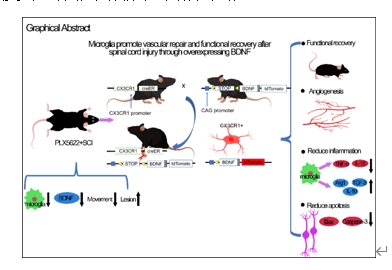中国神经再生研究(英文版) ›› 2026, Vol. 21 ›› Issue (1): 365-376.doi: 10.4103/NRR.NRR-D-24-00381
过表达脑源性神经营养因子的小胶质细胞可促进小鼠脊髓损伤后血管再生和功能恢复
Microglia overexpressing brain-derived neurotrophic factor promote vascular repair and functional recovery in mice after spinal cord injury
Fanzhuo Zeng1, 2, 3, Yuxin Li4 , Xiaoyu Li4 , Xinyang Gu4 , Yue Cao4 , Shuai Cheng1 , He Tian5, *, Rongcheng Mei2, *, Xifan Mei1, *
- 1 Department of Orthopedics, The Third Affiliated Hospital of Jinzhou Medical University, Jinzhou, Liaoning Province, China; 2 Department of Orthopedics, Xiangyang Central Hospital, Affiliated Hospital of Hubei University of Arts and Science, Xiangyang, Hubei Province, China; 3 Department of Neurobiology, School of Basic Medical Sciences, Guangdong-Hong KongMacao Greater Bay Area Center for Brain Science and Brain-Inspired Intelligence, Southern Medical University, Guangzhou, Guangdong Province, China; 4 Institute for Translational Brain Research, State Key Laboratory of Medical Neurobiology, MOE Frontiers Center for Brain Science, Fudan University, Shanghai, China; 5 Liaoning Provincial Collaborative Innovation Center for Medical Testing and Drug Research, Jinzhou Medical University, Jinzhou, Liaoning Province, China
摘要:
脊髓损伤是一种严重的中枢神经系统创伤性疾病,目前的治疗选择仍然非常有限。小胶质细胞是中枢神经系统中的关键免疫细胞,在脊髓损伤恢复过程中发挥着重要作用。为了研究小胶质细胞在脊髓损伤中的作用,实验在小鼠脊髓损伤前14天开始使用胶质细胞刺激因子1受体抑制剂PLX5622清除小胶质细胞,并在小鼠脊髓损伤后28天内继续清除小胶质细胞。结果发现持续清除小胶质细胞会导致脊髓损伤后病变面积的增大,下调脑源性神经营养因子的表达,并且会导致小鼠脊髓损伤后肢运动恢复能力的下降。因此,实验构建了小胶质细胞条件性过表达脑源性神经营养因子的小鼠,即CX3CR1 creER-/+:LSL-BDNF-/+-tdTomato(CX3:BDNF)。研究发现在小胶质细胞中过表达脑源性神经营养因子促进了脊髓损伤后小鼠后肢运动功能的恢复和血管生成。在脊髓损伤的急性期,在小胶质细胞中过表达 BDNF 可减少炎症因子的产生和神经元的凋亡。通过使用特异性标记小胶质细胞的转基因小鼠TMEM119 creER-/+:LSL-BDNF-+-tdTomato和在CX3:BDNF小鼠中使用一种不通过血脑屏障的胶质细胞刺激因子1受体抑制剂PLX73086,提示主要是小胶质细胞过表达脑源性神经营养因子产生了保护作用,而不是巨噬细胞过表达的脑源性神经营养因子发挥了保护作用。总之,实验证明靶向小胶质细胞过表达脑源性神经营养因子是促进脊髓损伤患者运动功能恢复的一种非常有前景的治疗策略。
https://orcid.org/0000-0002-4452-8005 (Xifan Mei)
